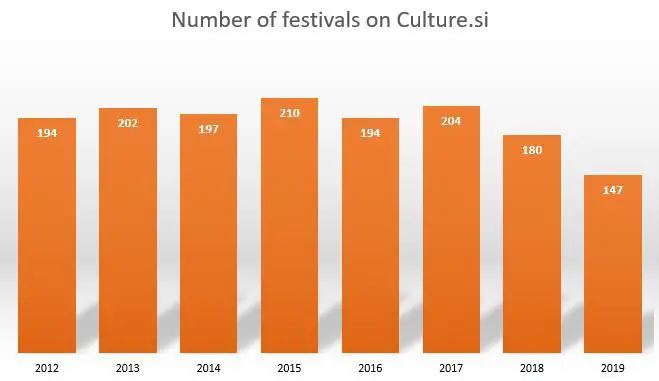Ljubljana related
STA, 13 June 2019 - As the number of tourists visiting Slovenia with camper vans grows, so is the number of places where they can stop for rest. Since a project encouraging municipalities to provide rest stops was launched in 2014, their number has risen to 160 rest stops.
As part of the Network of Rest Stops for Camper Vans, a project launched by the the Mirna municipality in the south-east, 90 of Slovenia's 212 municipalities have various types of rest stops, ranging from places offering only water and electricity to full-fledged camping sites.
The idea is to get all Slovenian municipalities on board to construct another 40 new rest stops to get to 200, project coordinator Petra Krnc Laznik told the STA on Thursday, as representatives of the participating municipalities met in Mirna.
Where to park a motorhome in Slovenia
The local communities which have already provided some infrastructure for camper vans should now more actively attract guests and adjust their offerings to camper van tourists. "They should try to keep them in their area, offering them unique adventures and memorable moments," she said.
"There are 212 municipalities in Slovenia and each of them could have at least one place where camper vans are welcome and where tourists can experience something nice," said project manager Dušan Skerbiš, the mayor of Mirna. In this way Slovenia would get "212 interesting tourist destinations".
Krnc Laznik added that Slovenia was becoming increasingly popular among foreign camper van tourists who also seemed to be very happy with the rest places here.
The map of rest stops, and more details about them, can be found here
STA, 30 May 2019 - The government has taken a key step towards the creation of a state-owned tourism holding by confirming on Thursday an investment document facilitating the transfer of several tourism companies onto a special company.
The confirmed investment document allows the Bank Assets Management Company (BAMC) to incorporate a special purpose vehicle onto which shares of Istrabenz Turizem, owner of six coastal hotels, will be transferred.
This company will form the basis of the State Hospitality Fund, which is "key to the continued consolidation of Slovenian tourism," the government said.
The State Hospitality Fund will be created to pool together the assets of several partially or wholly state-owned tourism firms that are individually weak but will have significantly better investment potential when merged.
Once the firms are consolidated, they will be sold in what Economy Minister Zdravko Počivalšek has described as "reasonable privatisation".
The State Hospitality Fund will feature assets of Istrabenz Tourizem, Sava Turizem, Hoteli Bernardin, Adria Turistično podjetje, Hit, Thermana, Unitour and Terme Olimia spanning hotels, spas, campsites and ski resorts.
STA, 20 May 2019 - The peak cruise ship season has started at the Slovenian seaside, with some 2,500 cruise passengers sailing into the Koper harbour last Saturday and almost 5,000 being expected this week.
MS Mein Schiff 6, which is part of the TUI Cruises' fleet and carries more than 1,000 crew members in addition to the passengers, arrived in Slovenia's only sea port for the first time on Saturday.
Being almost 300 metres long and over 40 metres wide, Mein Schiff 6 is one of the biggest ships the harbour has ever welcomed, said the Koper municipality.
To mark the occasion, the municipality's representatives as well as representatives of the port operator Luka Koper met with the ship's captain.
The ship is one of the fleet's new vessels, being launched in January 2017, and it embarked on its maiden voyage in June 2017.
It offers mid-priced cruises, accessible to a wider range of customers, with a few suites designed for more high-end passengers.
Koper expects to welcome three cruise ships this week, including MSC Musica on Tuesday, Marella Discovery on Wednesday and Viking Star on Friday.
MSC Musica, carrying some 2,000 passengers, will sail from Venice and later continue its journey to Zadar in Croatia.
Marella Discovery visited Koper already at the beginning of May and will make a stop in the Slovenian harbour again during its voyage to Venice, carrying some 1,800 passengers.
Viking Star, on the other hand, is a luxury cruise ship, having space for almost 1,000 passengers.
In a result that will shock followers of #igslovenia, the global travel site Big 7 Travel (part of Big 7 Media) has put together a list of the “Europe’s Most Instagrammable Places 2019”, with the sites / sight chosen for “theirvisual allure and popularity on social media”. Big 7 chose the winners using a comprehensive scoring system that analysed the amount of hashtags per destination, along with the survey results of Big 7 Media’s 1.5 million audience and the votes cast by a panel of travel experts.
With Slovenia at #13 – and the reminder that the best place to find the best curated images of Slovenia is at IG Slovenia, on their website, Facebook or Instagram – the top 10 list is as follows, while the top 50 can be seen here:
- Dubrovnik, Croatia
- Iceland
- Scottish Highlands, Scotland
- Budapest, Hungary
- The Cotswolds, England
- Kerry, Ireland
- Malta
- Côte d’Azur, France
- Kiev, Ukraine
- Vienna, Austria
Big 7 Media also carried out a survey to find out the effects of Instagram of people’s travel habits. The results showed that 67% of people surveyed said they have visited a new destination after seeing it on Instagram, while 61% of people have booked a specific hotel after seeing it on the same social media platform. Moreover, 33% of people surveyed said they research holiday destinations via their Instagram feed. with the the most popular travel content on the site being “Bucket List” experiences and luxury hotels.
STA, 19 April 2019 - Tourism contributed EUR 5.7bn or 12.3% to the Slovenian gross domestic product (GDP) in 2018, according to a report by the World Travel and Tourism Council (WTTC). The sector employed 110,700 people or 12.8% of total employment.
The annual contribution of tourism to the Slovenian GDP increased by 6% compared to 2017, the Slovenian Tourist Board said.
Related: 2018 Saw 8% Rise in Tourists, 10% in Nights, Strongest Growth from Abroad
In Europe, tourism contributed 9.7% to the GDP last year, an increase of 3.1 percentage points over 2017. Some 36.7 million people or 9.7% of all working Europeans were employed in the sector.
On a global scale, the tourism and travel sector directly and indirectly contributed EUR 7.825bn or 10.4% to the global GDP. The sector employed some 319 million people.
This year, tourism's contribution to the global GDP is set to increase by an additional 3.6%. The WTTC estimates that the total number of people employed in the sector globally will increase by 2.9%.
All our stories on travel and tourism in Slovenia are here
If you’ve ever wondered roughly how many festivals there are in Slovenia, how they’re distributed through the year, and where the main focuses are, then you’re in luck. The good folks at Culture.si have been producing interactive infographics with just this information since 2012. The one for this year, 2019, can be seen at the top of this story, while an interactive version with details in each square, can be found on the main website.
A few things to note from this year and others. One is the dominance of musical events, accounting for 48 out of the total of 146 festivals currently on the site for 2019, followed by dance & theatre (24) and film (22) – with food and drink festivals not included in these calendars. Another is summer being the clear peak season for festivals in Slovenia, with the top month being August.
A third observation, and a surprising one, given the seemingly relentless increase in tourist numbers, and thus tourist offers, over the last decade or so, is that the number of festivals isn’t increasing. While this could be due to data collection issues, since it’s already late March, and these events will have been planned for months, it seems likely some events have been consolidated or simply disappeared over time.
data from culture.su
You can play around with the infographic here, while you can see a list of all 215 festivals on Culture.si here. finally, readers interested in the history of festivals in Slovenia can explore this timeline, which gives the first appearance of each of the events.
Related: What's on in Ljubljana
FishingBooker, “an online community that enables you to list, find and book the best fishing trips worldwide” has released a list of the “10 best fishing holidays in Europe”, with Slovenia’s Lake Bled among the featured destinations.
As the site says in write-up of an area perhaps less known for its angling potential than its castle, church on an island, kremšnita and seasonal crowds:
Bled feels like a different world or maybe even a different century to most European holiday spots. Between Lake Bled’s island fortress, and the green slopes of the Julian Alps, the area seems almost too good to be true. Hundreds of thousands of tourists visit Bled every year to admire the serene beauty of this town. For anglers, Bled offers alpine, chalk stream, and freestone rivers full of four different trouts, all within half an hour of each other. And it’s not just about the rivers. Lake Bled is home to pike, carp, and even zander. All this, in one of the prettiest places in Europe.
The full list, in alphabetical order, is:
Bled, Slovenia
Costa Adeje, Tenerife, Spain
Dubrovnik, Croatia
Funchal, Madeira, Portugal
Herceg Novi, Montenegro
Inverness, Scotland
Lisbon, Portugal
Marbella, Spain
Santorini, Greece
Stockholm, Sweden
You can read FishingBooker’s full story here, while you can see all our posts on Lake Bled here, our posts on fishing here, and our slightly flawed but still delicious recipe for kremšnita here.
STA, 7 March 2019 - Ljubljana, the lakeside resort Bled and several other Slovenian towns included in the Slovenia Green scheme have been awarded at ITB Berlin, one of the world's largest and most prominent tourism trade fairs.
Ljubljana won in the category Best in Cities with its campaign promoting local food production entitled the Exchange of Local Foods.
The first meeting of producers and potential buyers of food from Ljubljana and central Slovenia was held in February and attracted more than 80 food producers, representatives of schools and kindergartens, hotels and restaurants.
"Locally produced ingredients are a trend in modern cuisine that is becoming an increasingly important element of Ljubljana's tourism, so we plan to continue with the Exchange of Local Foods ..." said Petra Stušek, the head of Turizem Ljubljana.
We just kicked off @ITB_Berlin 2019 with 35 Slovenian tourism partners ?
— Feel Slovenia? (@SloveniaInfo) March 6, 2019
?Visit us at Stand 109, Hall 17 and explore the culture and beauty of your favorite destination!
?https://t.co/F1OMIiM4TQ#ITBBerlin #ifeelslovenia #myway #itsculturetime pic.twitter.com/QoPz2zzcrY
Bled received the second prize in the category Best in Europe, which Tomaž Rogelj of Turizem Bled sees as a reward for the town's efforts in environment protection. It is also an encouragement for new measures promoting sustainable tourism, he said.
Meanwhile, Komen, Rogaška Slatina, Idrija, Koper and Podčetrtek were among the 25 finalists in the category for their efforts for responsible tourism, the Slovenian Tourism Board (STO) said after the accolades were handed out on Wednesday.
The Sustainable Top 100 Destinations awards are conferred by an NGO promoting sustainable tourism, Green Destinations, which declared Slovenia the first green country in the world in 2016.
Last year, Slovenia was among the top six most sustainable destinations in the world and the top in Europe.
A total of 64 destinations, service providers, parks and travel agencies in Slovenia are currently included in the Slovenia Green scheme and another 11 are to be included shortly, the STO said.
A leisurely walk in the woods in many countries, especially in my home country of England, invokes an image not only of peace and tranquillity, but also one of relative ease and safety. One of the advantages of the UK is that nothing really dangerous lurks in our woods; other than the odd crazy person with an axe or a gun. In Slovenia however, while you are less likely to encounter an axe-wielding homicidal maniac, there are other more natural dangers to be aware of: bears!
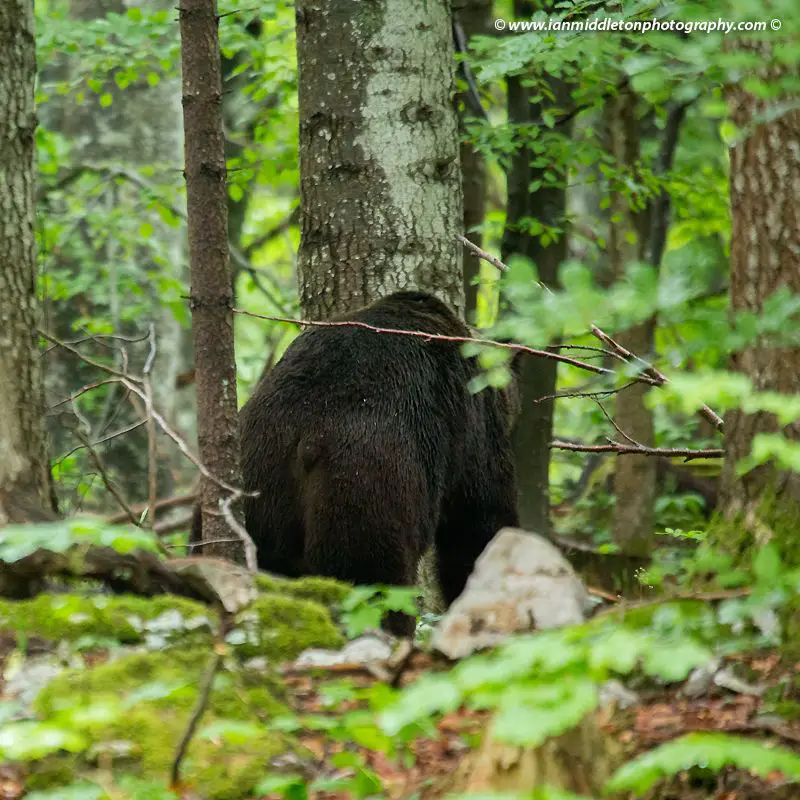
Brown Bear in the forest in Notranjska, Slovenia.
If you go down to the woods today, the likelihood that you’ll encounter a bear is extremely low. Over the years I have frequently gone driving and walking in areas where I had hoped to see or photograph them. Not a single sighting. Yet there is an estimated 800-900 European Brown Bears in Slovenia, bearing in mind (pun intended) that many of these bears and other wildlife routinely wander between Slovenia and Croatia. The brown bear is an elusive creature and at best it’s safer to go with a hunter, or an organised tour.
A few years back I did manage to find someone who had setup a series of hides specifically designed for photographers, so I was able to finally go on a bear watch and capture some great photos. However, while these are ideal for serious amateur or professional photographers, they are not so good for tourists who simply want to see the bears but don’t have the expensive camera equipment required to photograph them.
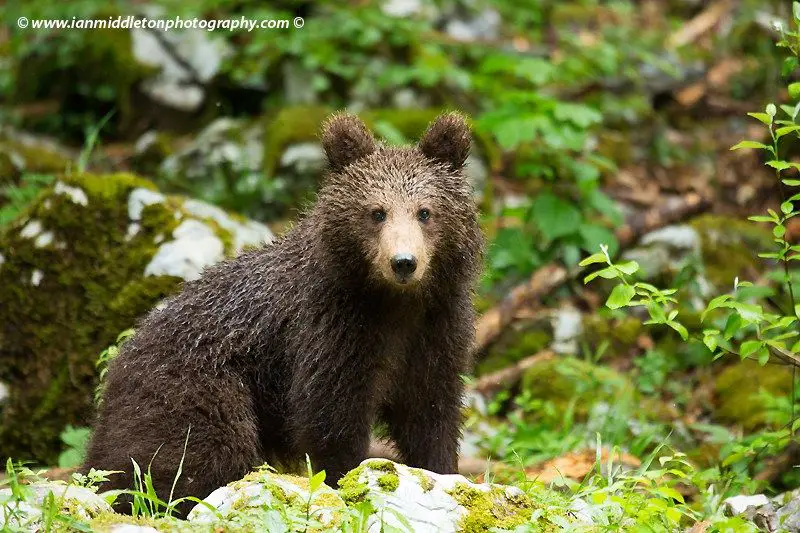
A one year old Brown Bear Cub in the forest in Notranjska, Slovenia.
So imagine my delight when I found Bears and Wildlife Tours. Based at the tourist office in the little village of Hrib, in the municipality of Loški Potok, they offer an array of wildlife watching tours as well as bear viewing huts. But the most intriguing of all, was the offer of staying the night in a simulated bear cave. I had to go and see.
The journey took me south from the capital Ljubljana to the border with Croatia, where I met with Tjaša, who organises and coordinates the tours, and Stanko, a local hunter and guide. We were already late into September so they told me that the chances of a sighting were low because the bears usually come out late in the evening, and as the sun is now setting earlier it would more than likely be dark by this time. But they would take me to see what they had to offer anyway.
Over a strong cappuccino, they told me a little about the bears and what they offer. They currently have about 7 hides in total, 3 in the Loški Potok region. This gives them much more scope to ensure a sighting for their guests. “We have never seen the same bear at each of our hides. The bears travel around 60kms per night or day. Many go from Loški Potok to Cerknica, and of course across the border,” said Tjaša.
The bears tend to travel over a specific area. A mother bear can remember from 5 years before where she got a good meal. Amazing, I struggle to remember where I ate yesterday!
Their numbers are increasing. In 1960 there was an estimated 150 bears in Slovenia. In 2018 that number was around 900. These numbers apparently swelled during the Balkan conflict; where many bears I guess fled here for asylum! I asked how it’s possible to know the numbers. “Hunters collect bear poo and send it to Ljubljana to the institute and from the DNA they can estimate their numbers. Every year the number is increasing,” replied Tjaša.
Mother bears in Slovenia are now giving birth to 3 cubs instead of 2. Rarely before have bears had more than 2. This is also an indicator that the quality of their habitat and food source is improving. 2018 was a particularly good year for food, as conditions that year made not only the forest rich with food, but the village orchards were overgrown with fruit. Stanko explained to me how September 2018 has seen an unusual rise in bears coming into the villages, much more than previous years. In autumn the bears are fattening up for the winter hibernation.
The improved quality of the habitat is partly down to conservation work, and rules being enforced that prevent hunters or bear tour organisations from feeding the bears within 2kms of a village. This helps stop them from wandering into villages in search of food and prevents any incidents with locals, and also accidents with cars. One of the biggest threats to bears is being hit by cars.
Every year the government sets an annual cull to try to control the population. For 2019 it was 200, increased from previous years because of the reasons above. However, this decision was suspended by the administrative court after a case was brought by the environmental protection organisation Alpe Adria Green (AAG).
A Winter Den and Bear Jacuzzi
After coffee we headed out for the first part of the tour. Stanko drove us to a location a few kilometres outside of town, where we stopped beside a forest road. He pointed to the forest and said that just up the hill is a winter den for a mother bear.
Bear dens are always close to water, so they can often be close to the road and village. Stanko and Tjaša then pointed to a stream running out of the forest to the roadside and told me how the bears will seek out sources of water, especially when it’s very hot.
These pools of water or streams are mostly deep in the forest well away from people and villages. However, they are also found on roadsides like this close to villages, because the water that runs off the forested hillsides collects in pools by the road. Stanko regularly comes here deer hunting and told me how, early one morning around 5am, he spotted a bear immersed in a pool of water up to its neck, with just its head poking out the surface.
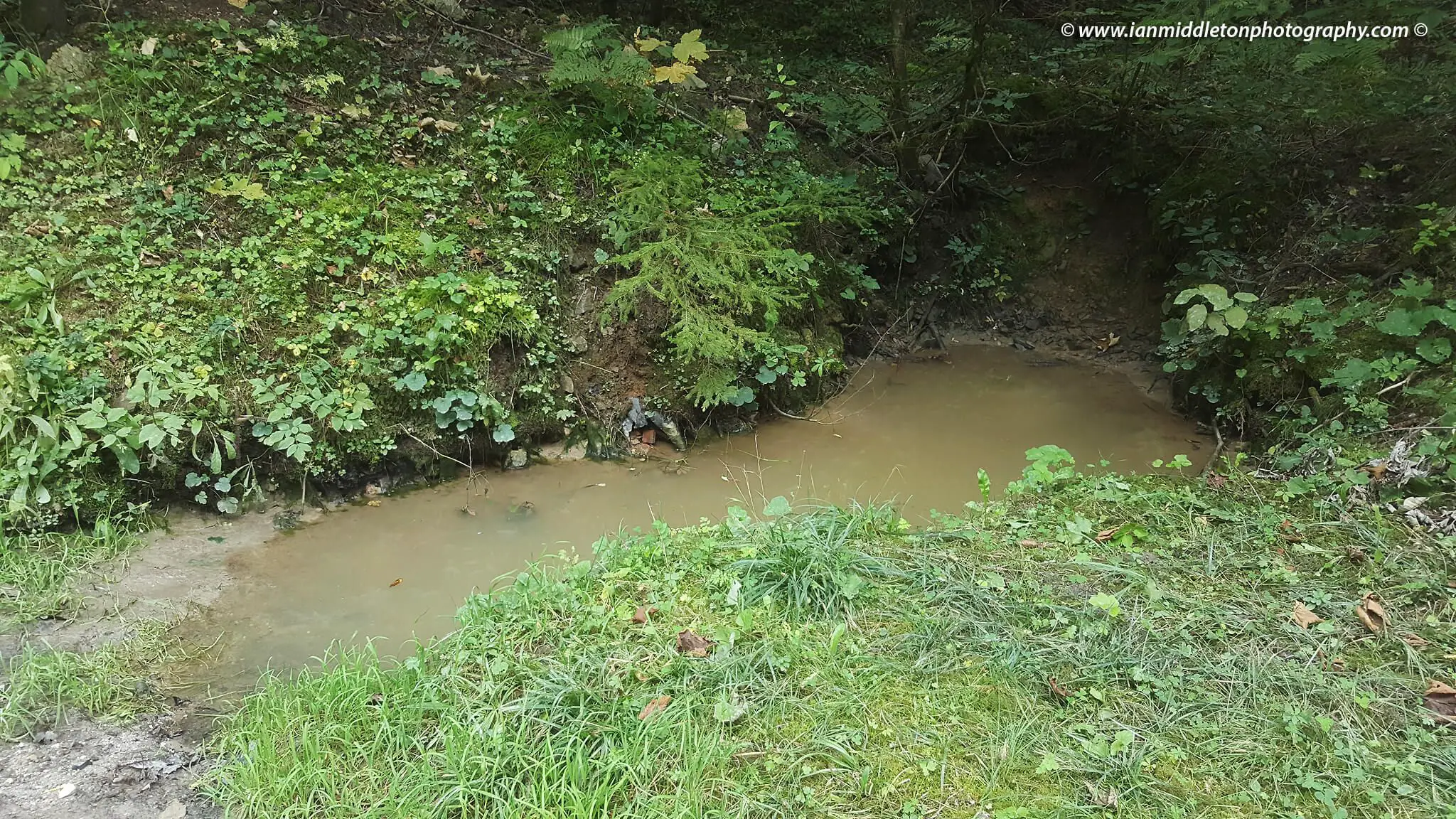
“I call it the Bear Jacuzzi”, he laughed.
The bears often come to these roadside pools to cool off in the heat of the summer days, and Stanko, and likely many locals, see them as they drive these forest roads.
Mushrooms – A national sport
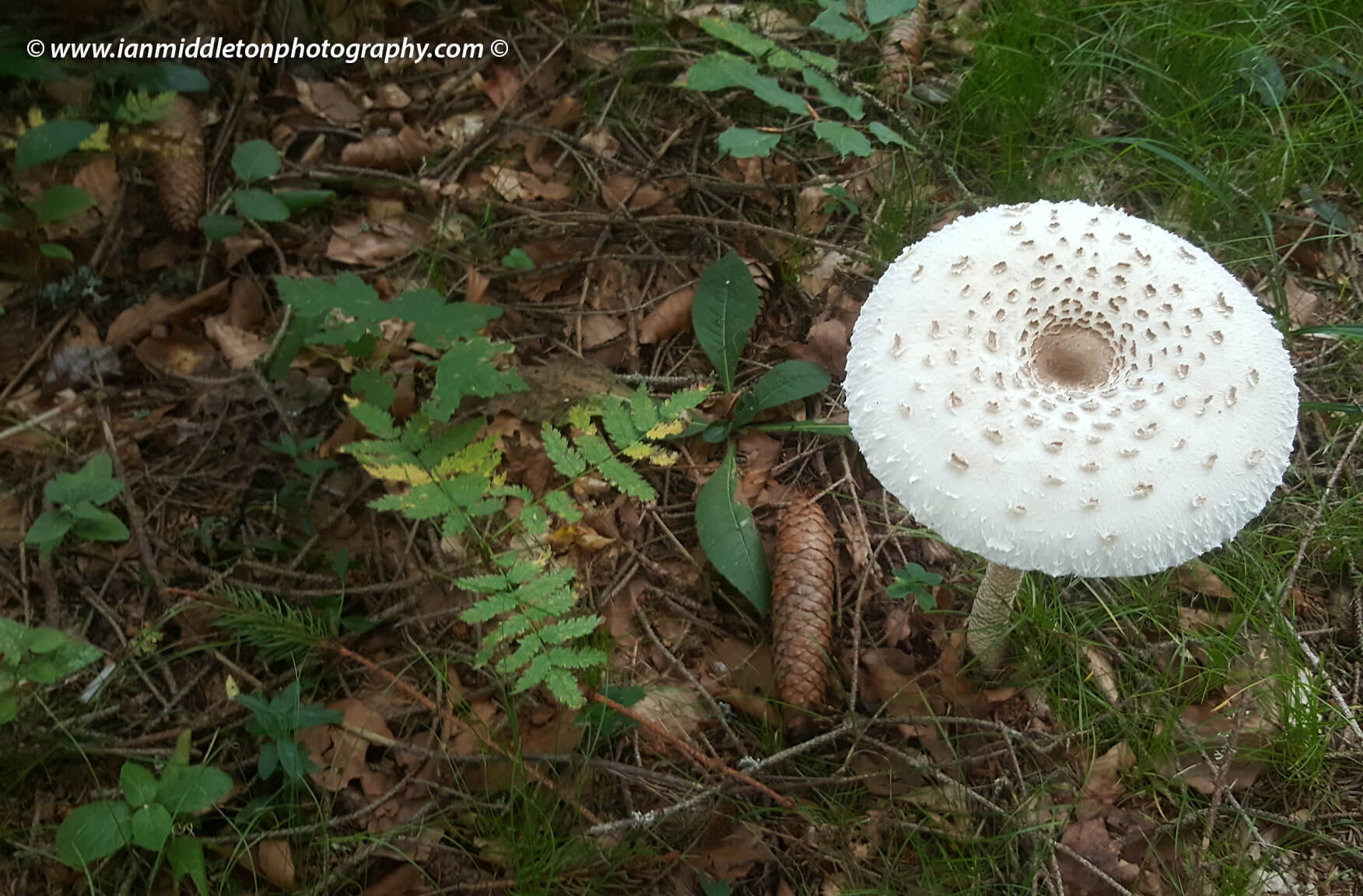
Wild Parasol mushrooms, known as Marela in Slovenia.. Macrolepiota procera or Lepiota procera
I then followed them up the hill to the winter den. On the way Tjaša picked some mushrooms and described how to prepare them. Mushroom picking, along with other forest fruits, is a national sport here in Slovenia. Every season the forests are packed with locals out mushroom picking, and they are usually racing each other to get the best and most. She also explained how to tell the difference between a poisonous and non-poisonous one.
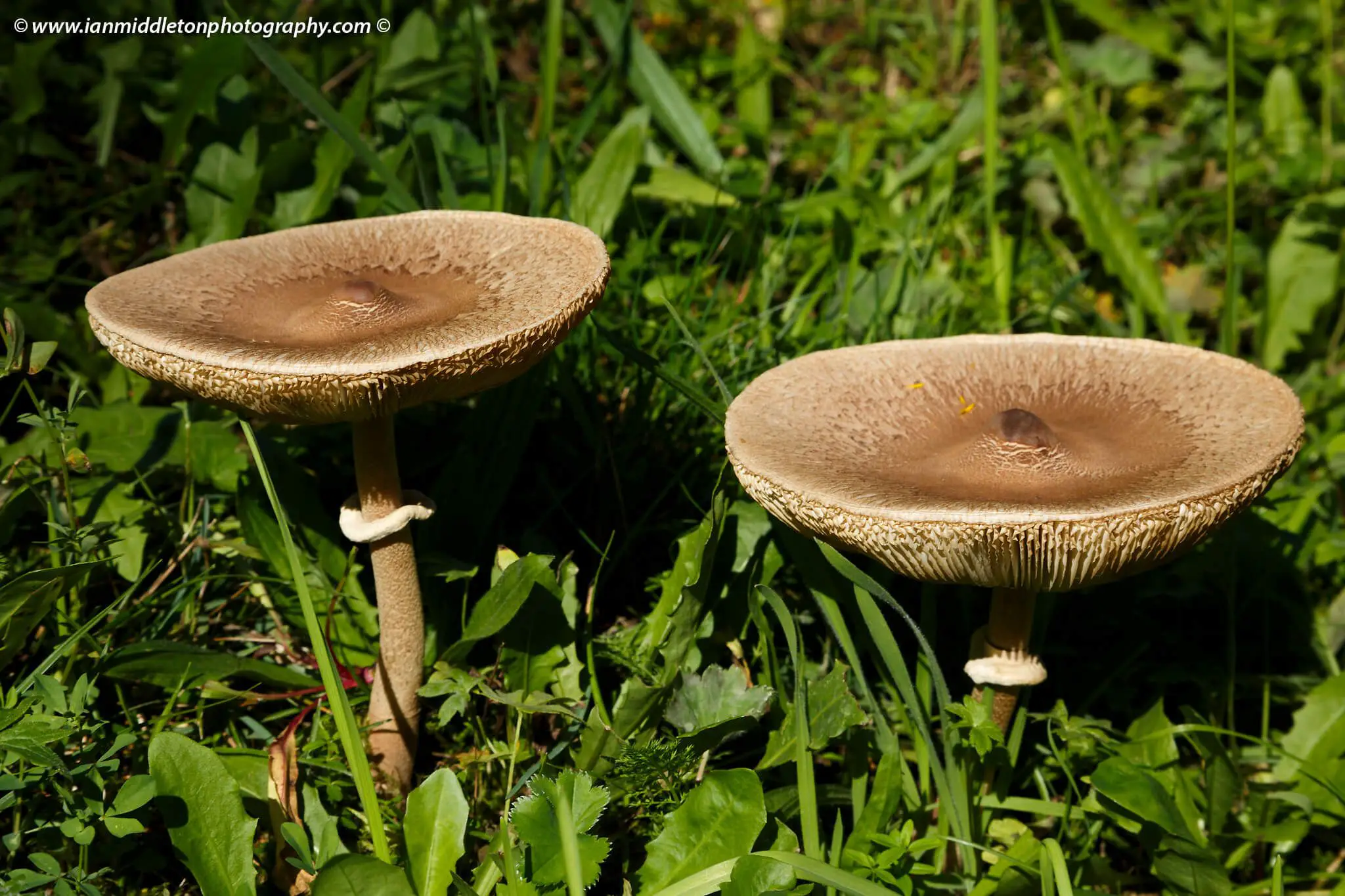
Wild Parasol mushrooms, known as Marela in Slovenia. As you can see, on the stem this circular piece is an indication that the mushroom is non-poisonous.
“I’ll take these to my mother in law’s tomorrow for cooking,” I said.
I feel I should add here that I fully intended to give my mother in law the non-poisonous mushrooms.
Slovenian folklore says that if you see a mushroom in the forest you must pick it immediately, no matter how big or small it is. Once someone has seen it, the mushroom will stop growing. Tjaša also explained that when you pick a mushroom you must clean it there and then in the forest before you take it away.
The bear cave
Bears hibernate during the winter in a den, essentially a small cave deep in a hillside. The entrance is narrow, but inside it is very wide and deep. The bear can get inside because its head and neck are very small and it doesn’t have a collar bone, so can squeeze its body through.
The bears enter the den when the first snow comes, or before if it’s a pregnant female. She will give birth in January and emerge from the den in April with her cubs. The cubs remain with the mother for two years. Therefore the bear has cubs every three years.
The male bear typically weighs 300kgs, while the female weighs 150kgs, so they can tell by the small size of the den that this is for a female only.
Responsible tourism
Bears and Wildlife Tours believe in keeping tourism to a minimum. Therefore they don’t have tours every day in the same location, so the wildlife isn’t disturbed too much. Bears can smell fresh blood from up to 4 kilometres away, and have excellent hearing too. If too many people are around the bears will hear and keep well away. Unless you are hunting!
On the way to our next destination, the viewing cave, Stanko told me a story about a time he shot a roe deer. Afterwards he placed his rifle against a tree and proceeded to cut open the deer and gut it. When he had finished pulling everything out, he took the gutted deer to his vehicle about 400 metres away.
Upon his return, Stanko got to within 100 metres to discover that between him and his rifle was a big male bear feasting on the leftover deer. It was not the most ideal of circumstances, so Stanko had no choice but to patiently wait before he could retrieve his firearm.
So to not only ensure the safety of visitors, but also ensure they don’t scare away the bears and other wildlife, they practice responsible tourism and ensure the numbers are kept low, and wildlife tours are conducted in different places each time.
There are very strict rules governing hunters and tourist organisations offering wildlife tours or trips to see bears in Slovenia. Along with the 2km rule, it is forbidden to feed the bears with farmed meat. But when gutting a deer it’s permitted to leave the leftovers in the forest for the bears to find, as long as they don’t find you first! But while an attack is undoubtedly terrible for the victim, it also means a death sentence for the bear. Once a bear has attacked a human being, it will be hunted down and killed. So these rules are not only there to protect people, but to protect the bears too.
Despite its love for meat, bears are actually 90% vegetarian. A sobering thought when you are just about to trudge through bear country.
Off to the bear viewing cave
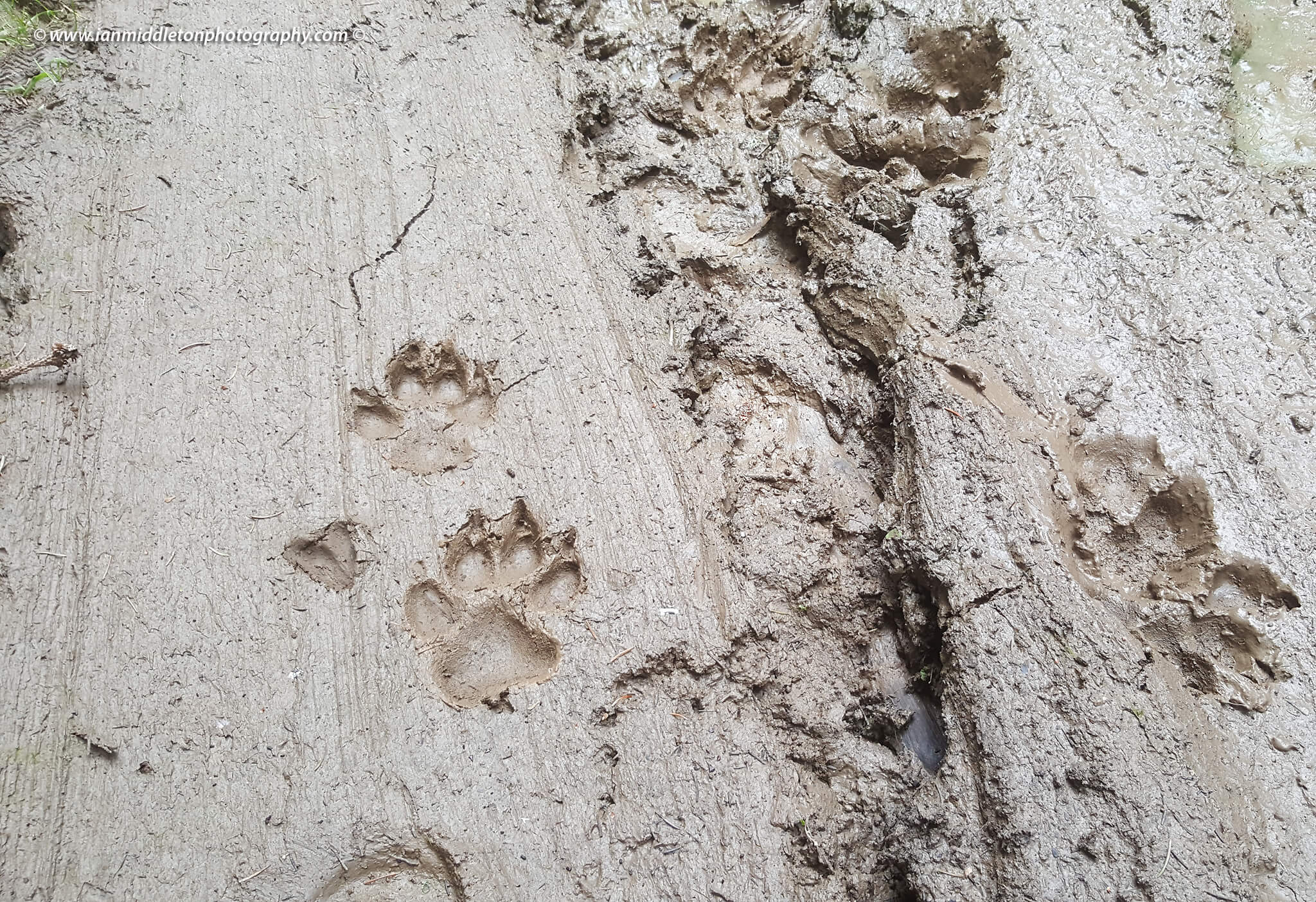
Wolf footprints in a forest in Loski Potok, Slovenia
We then headed off to the starting point of our walk deep into the forest to one of their viewing huts and, in this case, the bear viewing cave which you can sleep in. Along the way we spotted some wolf tracks, apparently attracted here because it’s deer mating season. As we got deeper into the woods I was told that from here on we must be very quiet and talk in whispers, or else the bears will sense us. In our case, we were here to spot them, so didn’t want to scare them off.
I just hoped the big bucket of apples that Tjaša was carrying wouldn’t encourage them to overcome their fear of humans!
What to do if you encounter a bear
Contrary to popular belief, bears are not the man-eating beasts they can often be portrayed as. In fact, they are very nervous creatures and will likely hear you first and keep well away. Attacks are usually the result of a bear being startled by a walker, or often a bird watcher who is not making any noise; or a photographer sneaking around to take photos. The bear will only attack if it sees no means of escape. Or if you inadvertently come between a mother and her cubs, you’re in for trouble.
Ordinarily when walking in the woods the advice is to never walk alone, and walk and talk (but don’t shout), make as much noise as possible in order to stay safe and avoid startling a bear, or other wild animal. This way the bear will hear you first.
There are many stories about what to do if you happen to surprise a bear. Although the instinct is to run, this is apparently the worst thing to do. A bear can run much faster than you, and if you run it will see you as a threat. Some say you should grab a stick and make yourself look big and loud. If the bear charges at you, remain still. Chances are it is a bluff and will veer away at the last minute.
Another crazy theory I heard is that you should run downhill, because the bear’s front legs are shorter and it cannot run fast downhill. But Tjaša laughed and said that the bear will still outrun you.
Tjaša’s advice is simple: back away slowly, always keeping your eye on the bear and it will very likely run away from you.
The Bear Cave
When we arrived at the viewing spot, a wide open meadow at the edge of the forest, Stanko went off alone first to check it was safe. Then they both prepared the food they would put out to try and attract the bears; Tjaša didn’t touch the food to ensure any human scent was kept to a minimum. For obvious reasons, the area was a short distance away from the viewing area. Tjaša explained that, for the reasons above, Stanko alone must go; no one else, not even her.
This particular viewing area is actually right beside the Croatian border. There are two places from which to observe the bears. The first is a viewing hut setup for both photographers and casual observers. The second is the specially designed bear cave. Here they have built a small wooden room into the rocks that is designed to simulate a bear’s den. Inside I was surprised to discover a cosy double bed and a row of seats next to small windows that look right out across the field to where the bears will hopefully come.
Stanko returned with a special night vision camera that they clamp to a tree where the bears are. It is triggered by movement so they can see when they are active at night. The previous night they came at 9pm, after dark. This was not looking promising for me. But as they had explained I was well into September now so the chances of a sighting during daylight were much lower.
The camera also showed a bear was here at 8.30 in the morning. So this goes to show that a night in this bear cave will undoubtedly increase your chances of a sighting. Sadly, commitments elsewhere meant I couldn’t stay the night.
The best time to take this tour is in high summer, from late May through June and July. August is also a possibility. The tours start at 16:00 and end at 22:00. There are several observation points like this, all on hills in areas of wide open space with lots of light.
But there is only one bear cave, and in this case you get to spend the night here. Naturally this increases your chances of a sighting, because you can also wake early and likely see them in the early morning.
Soon after, Tjaša and Stanko left. Just before he bolted the door, Stanko looked at me and said: “Do not go outside.”
I had no intention of doing that.
I was alone. All was quiet. I settled down for the evening, camera ready. When I had been on the photography tour a few years before we were extremely lucky that, not more than 30 minutes after settling into the observation hut, a couple of one-year old cubs came, followed by the mother and soon after a big male.
As the time ticked away I continued to live in hope. A bird of prey was swooping by occasionally, but sadly no bears.
Stanko returned to collect me after dark, and we trudged on through the forest without torches back to the car. Along the way he told me how he had been privileged to see a lynx in the forest. The Eurasian Lynx was reintroduced to Slovenia in 1973 by a hunter’s initiative. The current population is estimated at about 15-20. Thus not only are their numbers low, but they are very shy animals so a sighting is extremely rare. He showed me a photo he had. “It was a big privilege for me,” he said, proudly.
The love and respect that both Stanko and Tjaša have for the bears and other wildlife is clearly evident.
All this just goes to show how difficult it can be to spot the wildlife, and how important it is to go with an organisation like Bears and Wildlife Tours. Not only will they ensure your safety, as long as you follow their rules and instructions to the letter, but it will increase the chance that you too will be privileged enough to see one of these magnificent animals in their own habitat.
I had seen them before, but sadly not this time. However, I plan to return in May or June for another tour, and maybe even an overnight stay in a bear cave!
How to go
If you would like see bears, then visit the Bears and Wildlife Tours website. They also offer other wildlife tours, including as well as the bear cave, the opportunity to sleep on a rocky shelf in the forest and experience the sights and sounds of nature, with your guide there to keep you safe.
More info and bookings here: www.bearsandwildlife.si
Check out a video of the trip below:
For a more comprehensive look at Ian’s photography, check out his free e-book here. You can see many images in higher resolution, find other photo posts and subscribe to his newsletter here.
STA, 5 March 2019 - Maribor, Slovenia's second largest city, was visited by almost 202,300 tourists last year, up 13% from 2017, and the number of nights they spent there reached a record 451,610, a rise of as much as 36%.
The majority of nights was spent in Maribor by tourists from Germany, Croatia, Poland, Italy, Serbia and Austria, whereas only 13% of domestic tourists decided to stay more than one day.
The average period a tourist spent in the city thus increased from 1.86 days to 2.23 days.
"We've surpassed all set goals," Doris Urbančič Windisch, the director of the Maribor-Pohorje Tourist Board, told the press on Tuesday.
She attributed the upbeat figures to intensified promotional campaigns and a number of events taking place in Maribor.
Last year, the board promoted Maribor and the broader destination around the Pohorje hills at 22 fairs, ten workshops and four exchanges.
It moreover worked hand in hand with organisers of 65 local events.
Maribor and Pohorje play host to a number of interesting events, not least World Cup skiing races, the Lent summer festival and the Maribor Theatre Festival.
An event attracting a number of visitors is also the pruning of the Old Vine, which is more than 450 years old and is believed to be the oldest in the world.
"The Old Vine is one of our strongest trade marks which can take the good name of the city to the world and tell people that we appreciate our past and can build new stories on its basis," Mayor Saša Arsenovič, the new Old Vine master, said.
The pruning is an opportunity for the city to give Old Vine grafts to towns around the world to strengthen cooperation with partners from Slovenia and abroad.
The Žametovka or Modra Kavčina vine has won a place in the Guinness Book of Records as the oldest cultivated vine in the world still bearing grapes.
The vine was planted towards the end of the Middle Ages, when Maribor was facing Ottoman invasion, and grows in the old city centre in front of the Old Vine House.
All our stories about Maribor can be found here, while those about tourism are here


